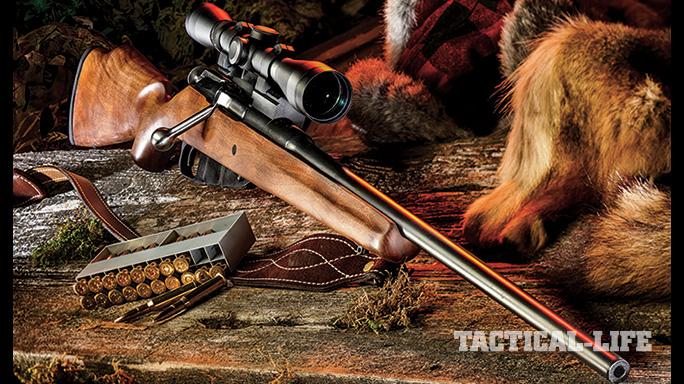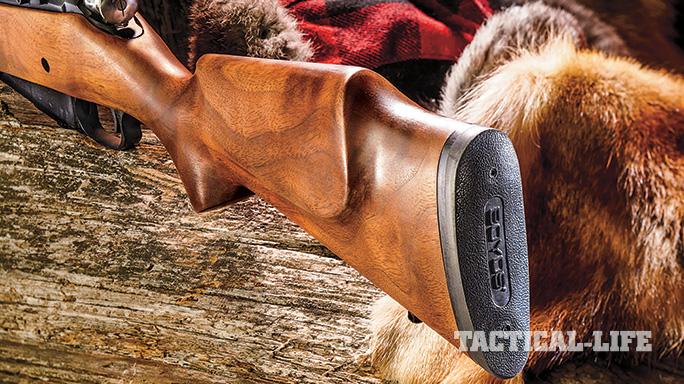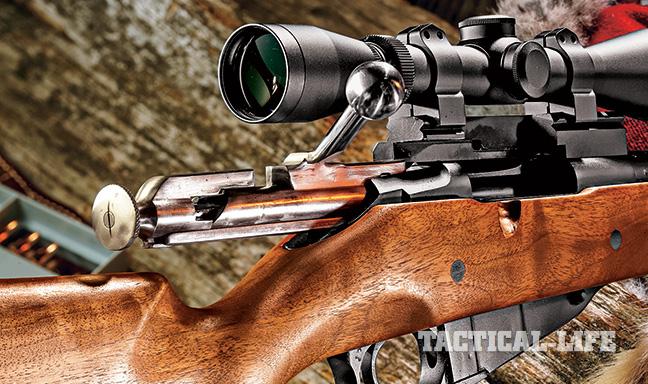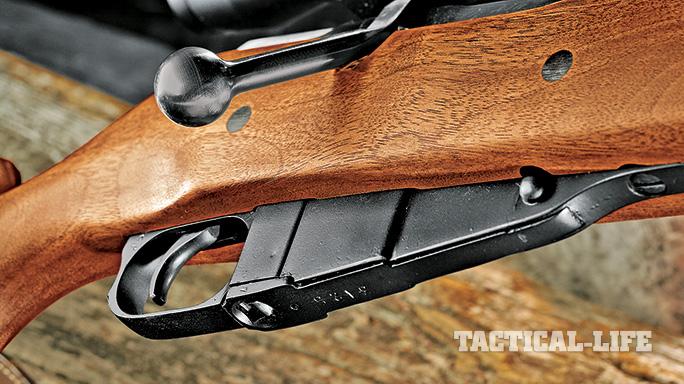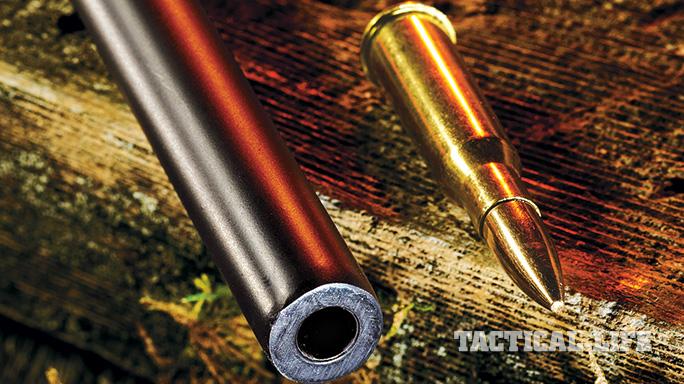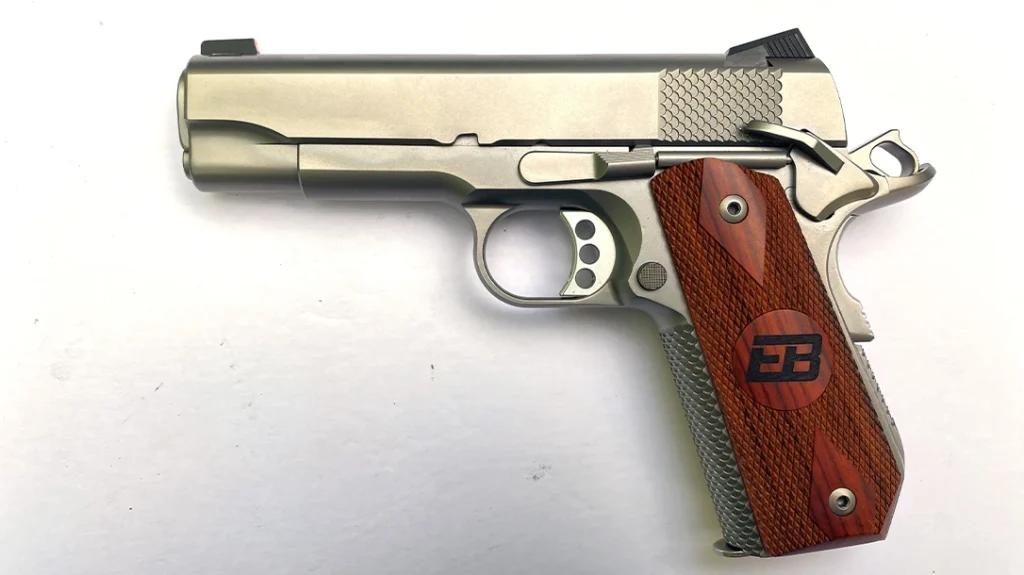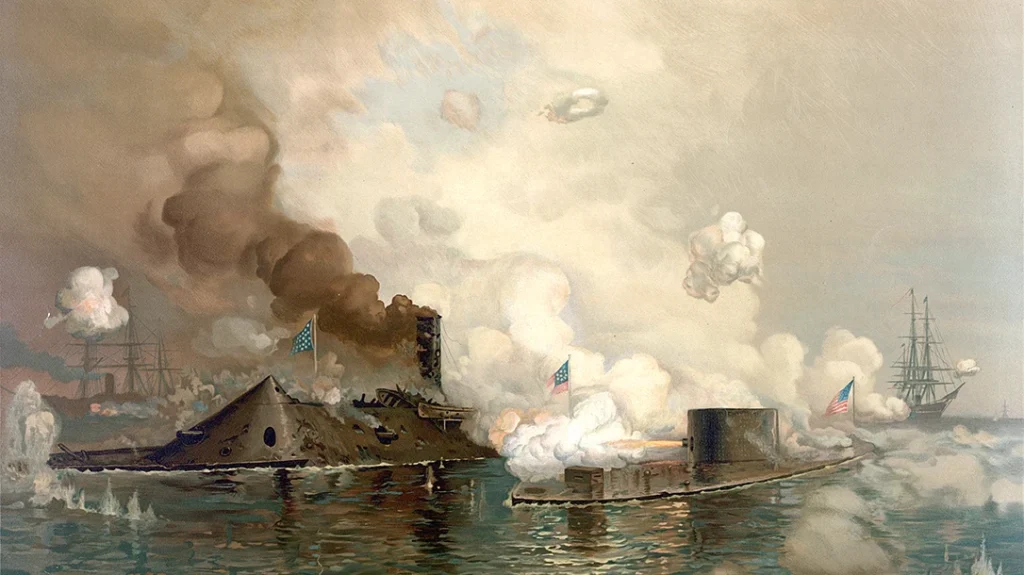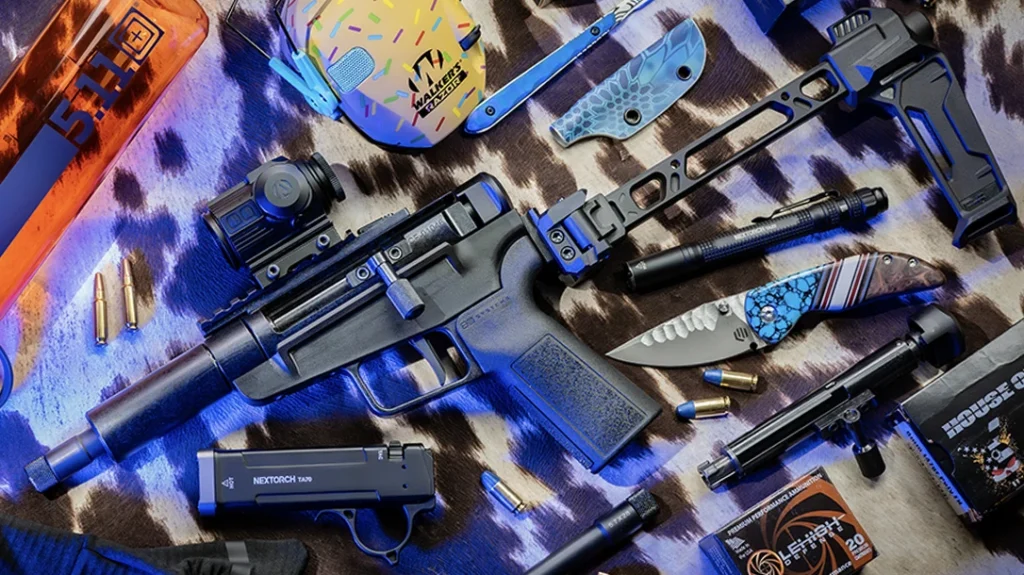Before we get too far out of the gate, fair warning: The article you’re about to read involves brutally chopping up a military classic, the Russian Model 91/30 Mosin-Nagant battle rifle of the 1930s and 1940s. While these things were made literally in the millions, and imported to our shores in large numbers for the past 15 or so years, there are many military-surplus purists who develop heart palpitations at the mere idea of altering a “classic” in any manner, way, shape or form.
- RELATED STORY: The Russian Mosin-Nagant 7.62x54R Military Rifle
“These are pieces of history and they should be passed down to posterity as examples of history! And that means intact, mister!” While I share that viewpoint to a degree, I don’t personally regard the Mosin-Nagant as being quite in the same category as Sergeant Alvin York’s 1911 .45 ACP, Winston Churchill’s iconic Thompson or Patton’s Colt .45 Peacemaker.
Russian Fighters
Advertisement — Continue Reading Below
The Mosin-Nagant rifles are a bit different, and here’s why. At the end of World War II, the Soviet military apparatus recalled all Mosin-Nagant rifles not currently needed by a shrinking postwar army and refurbished them before stashing them in armories as emergency war reserves. That included re-barreling, re-bluing, re-stocking and rebuilding in general, including small parts replacements, as needed. In other words, while you could conceivably stumble across a rifle at your local gun shop that participated in the Battle of Berlin in April of 1945 that effectively ended the Third Reich, chances are unlikely that it’d be entirely the same rifle. You could easily have a hexagonal receiver from 1929 mated to a postwar barrel riding in a laminated stock from the late 1940s bearing more than one arsenal stamping and the much later import company’s markings. The Soviets weren’t concerned with maintaining a “piece of history” in original form; their goal was to return a fighting tool to fighting trim, and in doing that there was a lot of mixing and matching going on. So, many of the rifles we see today lined up on the surplus rack dangling $129 price tags were already altered in some way from their originally issued state 50 years before they ever left Mother Russia’s dusty warehouses on the way here. And they have not always survived in precisely pristine condition.
Add that to the sheer numbers shipped and I think it’s perfectly permissible to ask the die-hard collectors, “Just how many of these millions of rifles do we really need to stick in museums and pass down for posterity in their ‘original’ military form?” Admittedly, I’ve never yet been able to bring myself to sporterize a classic Mauser or Enfield, but let’s be real here—there are more than enough Mosin-Nagants in varying grades and configurations out there to keep the collectors happy collecting and the sporterizers happy sporterizing.
The Inspection
Advertisement — Continue Reading Below
With that said, if the goal is a thoroughly modernized rifle with a better stock, a scope, and a more maneuverable barrel than that 28-incher the Russian infantry liked so well, how do you get there? First off, if that is your goal, understand going in that this project is a labor of love (or at least fun), and you’ll probably put far more money into it than a $129 gun is worth unless you already have some components, do most of the work yourself or can find everything on sale.
The best way to start out is to find a Mosin-Nagant rifle you can look at in your own two hands. The wood’s condition doesn’t matter, so pay more attention to the barrel, action and bolt. The bores are usually in great shape with strong rifling; shine a light down the barrel of your rifle if you can. Check to make sure the bolt and receiver have matching stamped serial numbers, not electro-penciled numbers. Run the bolt; it should cycle fairly smoothly, but it might not if there’s too much preservative cosmoline inside the chamber or raceway. Check to see if the trigger moves freely, dry-fire it once if the shop will let you. Make sure it works. Don’t worry if the front sight’s off-kilter, or the barrel bands are loose, or the buttplate’s rusty. Those are all going away. Do watch for deep rust pitting on exterior steel surfaces; some can be deep enough to weaken the barrel, and unfortunately the ones most likely to do so are typically buried under the wood line, where you can’t see them until the stock comes off.
Disassemble & Degunk
Advertisement — Continue Reading Below
Once you’re home, you’ll have that cosmoline to deal with, but since you won’t be retaining the original wood, there’s no reason to bother cleaning up the stock parts. Remove the bolt by pulling it out of the receiver while holding the trigger back. Remove the handguard by depressing the barrel-band retaining springs, sliding both bands forward and lifting the guard off. The rear band will slide around the front one and over the hooded front sight, but you’ll need to spread the slightly smaller front band to clear the sight. Remove the two action screws, front and rear, lift the barreled action up out of the stock, and remove the magazine/trigger assembly from the bottom. (Watch the trigger pin—it’s frequently loose and likes to make a break for freedom when nobody’s looking.)
You can use any cleaner/solvent on a rag or paper towels at this point to de-gunk the metalwork you’ll be keeping—with good ventilation. Scrub the bore thoroughly with your favorite cleaner. I start with a few cotton patches and Shooter’s Choice to handle any old traces of copper remaining, then repeatedly apply a bronze bore brush (not stainless) and follow up with Break Free CLP on several more patches.
Once the bore, chamber and bolt raceways are clean and lightly oiled, wipe down the outside metal surfaces well with a cleaning fluid. I do it until the brown cotton patches or rag lighten up as indications that most of the rusty patina is lifted. Then, break the bolt down and get any last remaining cosmoline out that can interfere with the firing pin’s movement. (There are several Internet sources for tutorials on how to do this, and how to check for correct firing pin protrusion using the combo gauge/screwdriver in your rifle’s accessory cleaning kit.) Open the magazine by pulling the catch at the bottom to the rear, and swab out any cosmoline you find lurking in dark corners. With a lightly oiled bolt and a light coat of oil on your barreled action surfaces, you’re ready to sit back and decide on your next step.
Advertisement — Continue Reading Below
Stock Options
Bearing in mind that this will be a shooter, not a bragger, there isn’t much sense in paying for fancy (read expensive) wood. You can find alternative materials and thoroughly modern designs (see the sidebar on the Archangel AA9130 install), but when setting up my 1940 Tula Arsenal rifle, I stayed with traditional walnut in the form of a Prairie Hunter stock from Boyds’ Gunstock Industries. The oil-finished stock features a high Monte Carlo comb with a left-side cheekpiece, sling studs and a fairly hard, non-ventilated rubber recoil pad. I like how it looks, and while it’ll eventually get a better pad, it shoulders well and positions my eye comfortably with the glass I chose for the Mosin-Nagant. This stock weighs roughly 2.8 pounds, and it’s proportioned to look right at home with 22- to 26-inch barrels. Advertised as fully inletted for drop-in installations, you may need to do some minor tweaking to fit your rifle’s action. My solid walnut version cost $119, while the same stock in either pepper or nutmeg laminate costs $97.
Glass It
Advertisement — Continue Reading Below
If you’re happy with iron sights, you can stop here. I wasn’t, and the rifle needed a scope to maximize the accuracy potential I wanted to see in it. I called Leupold for advice and obtained a 3-9x40mm VX-1 scope with a matte black finish and a standard duplex reticle. This lead-free, 11.2-ounce scope uses Leupold’s proprietary Multicoat 4 technology for improved light transmission, 0.25-MOA finger clicks (no screwdriver or coin-slotted drum adjustments), a 34.6-foot field of view at its lowest magnification and a 14.6-foot field of view at its highest, and at an MSRP of $249, it gives the Mosin-Nagant rifle adequate magnification at all practical ranges for the 7.62x54R chambering it uses.
You can go higher or lower in pricing your glass, but coupled with a set of $40 low steel Warne Maxima Fixed Rings to fit Weaver-style bases, this U.S.-made Leupold scope will get the basic job done for me with a name I trust.
Because of the Mosin-Nagant’s receiver dimensions, you won’t be able find a scope base for it at a store like Wal-Mart. Rock Solid Industries (RSI) produces several handy products for sporterizing Mosin-Nagants, one of which is a three-point, hardcoat anodized 6061-T6 aluminum mounting rail. There are other scope mounts on the market, but this one creates full support at the rear, and it works well with the Warne scope rings. You can order this scope mount to fit either hex or round receivers and prices range from $100 to $110, including three mounting screws, a hex wrench and detailed instructions if you’re handy with power tools.
Advertisement — Continue Reading Below
Since the short bolt handle rides straight up when cycling to the rear, it obviously can’t work with a scope. RSI has three options to help out there: a handle you can order and weld onto your own bolt for $30 (advanced skills required); a surplus bolt body the company modifies with its own handle and sells as a unit at $80 (simple skills required to disassemble your bolt and reassemble with the body/handle); and RSI welding its handle onto your bolt when you send it in for that service for $50 on top of the handle cost (only basic packaging skills needed here). I opted for the latter option, the safest way to go for tool-challenged people like me, and the bolt came back beautifully modified with no visible signs of the TIG welding done to it whatsoever. A set of $10 RSI aluminum bedding pillars finished the parts shown, which I highly recommend.
All Together
Once all the aforementioned pieces were worked out, the barrel was cut back to 22 inches, the rear sight and its dovetail base were surgically removed, and the barreled action and magazine were DuraCoated. When the milling, drilling, hacking and bedding was finally finished and the Leupold was mounted, the difference was night and day. The rifle was transformed from a well-worn warhorse with flaking wood varnish, sights built to aim here and hit there on the battlefield, and a shoulder-thumping steel buttplate into a good utilitarian sporter with oiled wood, a passable recoil pad, a more uniform and rust-resistant steel surface finish, a shorter barrel for easier maneuvering and a fully adjustable and precise sighting system.
Advertisement — Continue Reading Below
Paper Punching
With two commercial loads and one 1978 surplus Russian sardine-can load, firing the “new” sporter was quite a change from shooting a Mosin-Nagant in full military trim. The stock and scope height was a better fit for my long neck; the glass showed a very clear 100-yard bullseye; the straight, extended bolt handle introduced infinitely better leverage in opening the action (especially noticeable on the Hornady steel-cased loads that tend to give my Mosin-Nagants fits on opening); the bolt remained smooth and easy all the way through the session (which isn’t always the case with un-modified Mosin-Nagants); and the 8-pound rifle’s recoil was distinctly softer on the shoulder than in its original
military configuration.
- RELATED STORY: 6 Russian Sniper Rifles From WWII and Beyond
Mosin-Nagant barrels can vary greatly, and yours may do better than mine, which created a best three-shot, 100-yard group measuring 0.75 inches with Hornady’s 174-grain BTHP hunting round, but I can live with that kind of accuracy.
Advertisement — Continue Reading Below
The cost of the additions is probably about three times what the rifle’s worth now, but sometimes value just isn’t the decider. I can truthfully say that nobody else has a Mosin-Nagant just like mine. If you’re interested in giving an old gun a new life, the Mosin-Nagant is a great place to start.
FOR MORE INFORMATION
- Boyds Gunstock Industries: boydsgunstocks.com; 605-996-5011
- Leupold: leupold.com; 800-538-7653
- Rock Solid Industries: rocksolidind.com; 660-259-2832
- Warne: warnescopemounts.com; 800-683-5590
